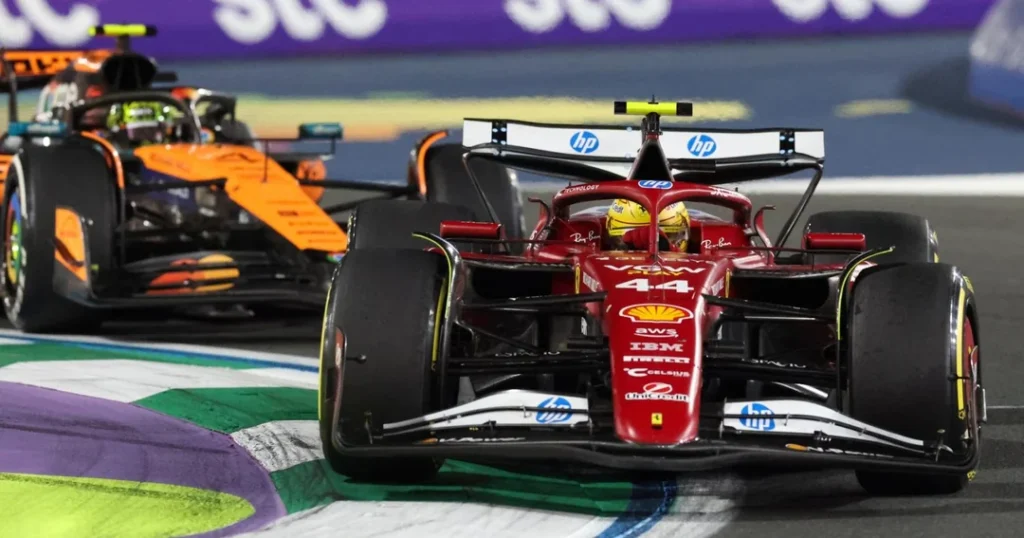
Ferrari’s podium in Jeddah wasn’t just a well-executed undercut or a lucky break, it was a glimpse at a fundamentally different Ferrari. The Scuderia’s first podium of the 2025 season, secured by Charles Leclerc (not including Lewis’ sprint win), showcased a car that’s finally delivering over race distance, paired with the subtle brilliance of Lewis Hamilton in support.
The Hidden Advantage: Ferrari’s Fix for a Longstanding Flaw
Historically, Ferrari’s cars have struggled with front tire wear, blazing fast over one lap but unpredictable and uneven in race conditions. That changed in Jeddah. This year’s SF-25 showed improved composure through corners, with Leclerc’s onboard lap revealing a level of mid-corner stability we haven’t seen from a Ferrari in years. Instead of reacting to the car’s quirks, Leclerc drove with visible confidence.
The key? A setup philosophy that favors balanced degradation and aerodynamic consistency over raw qualifying pace. In particular, Ferrari’s success in managing dirty air has become a cornerstone of their performance, an essential trait at circuits like Jeddah, where staying in DRS range without overheating the fronts is vital.
For the first time in a long time, Ferrari’s engineering decisions feel proactive, not reactionary. This wasn’t a Band-Aid performance: it was a measured, deliberate approach that emphasized tire longevity, consistent cornering, and strategic control.
Hamilton’s Quiet Influence: Tactical Racecraft in Action
Perhaps the most understated highlight of the weekend came from Lewis Hamilton, not by chasing a podium himself, but by protecting one for his teammate.
In the final phase of the race, Hamilton emerged from the pits directly in front of Lando Norris, effectively acting as a buffer between the McLaren and Leclerc. While not overtly defensive, Hamilton timed his pace perfectly: fast enough to stay ahead, slow enough to disrupt Norris’ ability to chase down the podium.
This wasn’t a coincidence, it was orchestration. Hamilton’s positional awareness and race IQ allowed Ferrari to control the final stint and secure P3. McLaren boss Andrea Stella admitted as much post-race: “If Hamilton hadn’t been in the middle, we could’ve fought for P3.”
It’s moments like these that show the value of Hamilton’s arrival in red. He’s not just a title threat, he’s a strategic asset. And in a tightly contested midfield fight, that’s priceless.
Execution Over Excitement: Ferrari’s Shift in Philosophy
Ferrari’s strength in Jeddah didn’t lie in showy overtakes or blinding pace. It was their ability to execute every component of the race with precision: tire strategy, pit timing, pace control, and intra-team synergy.
They’re no longer gambling on safety cars or praying for rain. This is a team starting to play the long game.
And yet, it’s not time for champagne just yet. One podium doesn’t rewrite history. We’ve seen Ferrari flash brilliance before, only for it to dissolve into inconsistency. But if the SF-25’s tire behavior, Hamilton’s racecraft, and Leclerc’s confidence hold across different track profiles, particularly upcoming races like Miami and Imola, this could be a legitimate turning point.
Is This the Real Ferrari?
The signs are there: a car that doesn’t chew its tires, a driver lineup capable of playing both offense and defense, and a strategy team that, for once, isn’t getting outmaneuvered.
Whether this is a resurgence or a brief moment of clarity remains to be seen. But one thing’s clear: Ferrari in 2025 finally looks like a team thinking three moves ahead.
And that might be their most dangerous quality yet.
